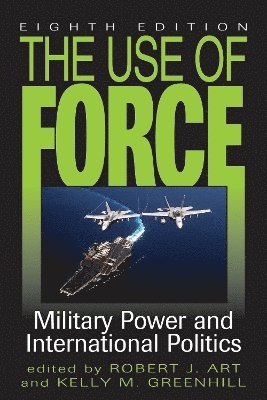
- Format
- Häftad (Paperback / softback)
- Språk
- Engelska
- Antal sidor
- 480
- Utgivningsdatum
- 2015-07-09
- Upplaga
- Eighth Edition
- Förlag
- Rowman & Littlefield
- Medarbetare
- Art, Robert J. (ed.), Greenhill, Kelly M. (ed.)
- Dimensioner
- 251 x 180 x 15 mm
- Vikt
- Antal komponenter
- 1
- ISBN
- 9781442233058
- 681 g
The Use of Force
Military Power and International Politics
- Skickas från oss inom 7-10 vardagar.
- Fri frakt över 249 kr för privatkunder i Sverige.
Passar bra ihop
De som köpt den här boken har ofta också köpt The Courage To Be Disliked av Ichiro Kishimi, Fumitake Koga (häftad).
Köp båda 2 för 1120 krKundrecensioner
Fler böcker av författarna
-
Coercion
Kelly M Greenhill
-
Weapons of Mass Migration
Kelly M Greenhill
-
Sex, Drugs, and Body Counts
Peter Andreas, Kelly M Greenhill
-
A Grand Strategy for America
Robert J Art
Recensioner i media
For more than two decades, The Use of Force has been the 'go-to' book for both introductory and advanced courses in security studies. Like its distinguished predecessors, this new edition still combines classic theoretical articles and up-to-date analyses of critical contemporary issues. If you are going to assign one book to your students, this is the one. -- Stephen M. Walt, Robert and Renee Belfer Professor of International Affairs, Harvard University The Use of Force has long been the leading reader in the area of security studies. It deftly combines the 'classics' with the best new scholarship on emerging issues, and takes care to present competing perspectives. I have used it for years and hope to do so for years to come. -- Peter Feaver, Triangle Institute for Security Studies, Duke University It is hard to imagine a better collection of traditional security analyses by prominent realist scholars. -- Deborah Avant, Josef Korbel School of International Studies, University of Denver Like the eighth edition of The Use of Force you will. -- Yoda
Övrig information
Robert J. Art is professor of international relations at Brandeis University. Kelly M. Greenhill is associate professor of political science at Tufts University and research fellow at the Kennedy School of Government, Harvard University.
Innehållsförteckning
Preface PART I STRATEGIC AND ETHICAL DIMENSIONS How Force Is Used 1 The Fungibility of Force Robert J. Art 2 Deterrence and Compellence Thomas C. Schelling 3 The Sources of Military Doctrine Barry R. Posen 4 Offense, Defense, and Cooperation under the Security Dilemma Robert Jervis How Force Should Be Used 5 The Just War Tradition Revisited Seyom Brown 6 The Proportionality Principle in War Laurie R. Blank Forms of Coercion 7 Nuclear Myths and Political Realities Kenneth N. Waltz 8 The Lost Logic of Deterrence Richard K. Betts 9 Coercive Diplomacy Alexander L. George 10 What Terrorists Want Louise Richardson 11 Forced Migration as a Coercive Instrument Kelly M. Greenhill PART II CASE STUDIES The Great Power Era 12 The Cult of the Offensive in 1914 Jack L. Snyder 13 Hitler and the Blitzkrieg Strategy John J. Mearsheimer 14 Japans Fatal Blunder Sir George Sansom 15 The Decision to Use the Atomic Bomb Louis Morton The Superpower Era 16 The Cuban Missile Crisis David Welch, James G. Blight, and Bruce J. Allyn 17 Flexible Response and the Vietnam War John Lewis Gaddis The Unipolar Era 18 The U. S. and Coercive Diplomacy Robert J. Art and Patrick M. Cronin 19 The Second Iraq War Peter R. Mansoor 20 The Limits of Counterinsurgency Doctrine in Afghanistan Karl W. Eikenberry PART III CONTEMPORARY ISSUES The Projection of American Military Power 21 The Strategy of Restraint Barry R. Posen 22 The Strategy of Deep Engagement Stephen G. Brooks, G. John Ikenberry, and William C. Wohlforth 23 Crisis Instability in US-China Relations Avery Goldstein 24 Why Drones Work Daniel Byman The Utility of Nuclear, Biological, and Cyber Weapons 25 Nuclear Weapons and Conflict Mark S. Bell and Nicholas L. Miller 26 Pathogens as Weapons Gregory Koblenz 27 The Myth of Cyberwar Erik Gartzke Intervention in Internal Conflicts 28 Puttering with Primacy Richard K. Betts 29 Humanitarian Intervention Comes of Age Jon Western and Joshua A. Goldstein 30 Regime Change and Its Consequences Alexander B. Downes 31 Ten Ways to Lose at Counterinsurgency Kelly M. Greenhill and Paul Staniland 32 The Critical Barrier to Civil War Settlement Barbara F. Walter Possible Future Developments 33 The Decline and Demise of Terrorist Groups Audrey Kurth Cronin 34 A World Without Nuclear Weapons? Thomas C. Schelling 35 Law, Ethics, and Autonomous Weapons Systems Kenneth Anderson and Matthew Waxman Acknowledgments Index About the Contributors
Du kanske gillar
-
Animal Farm
George Orwell
Häftad -
Hillbilly Elegy
J D Vance
Häftad -
The Way Home
Mark Boyle
Häftad -
Way Of Kings
Brandon Sanderson
Inbunden


